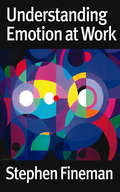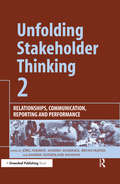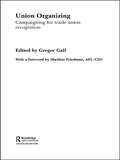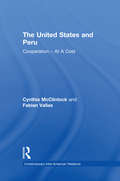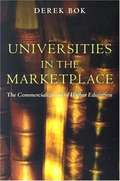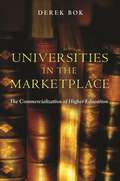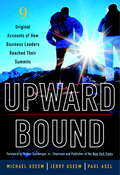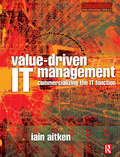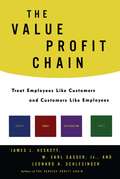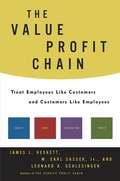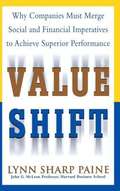- Table View
- List View
Understanding Emotion at Work: Sias, Organizing Relationships + Fineman, Understanding Emotion At Work
by Stephen Fineman`Most folks in organizations dichotomize reason and emotion, often treating emotion as an uncommon or marginal occurrence. Written in a clear and lively style, Steve Fineman's book, Understanding Emotion at Work, dispels this notion as he demonstrates how emotions infuse most practices in organizational life, including leading, decision making, organizational change, gender relations, stress, and downsizing. Sprinkled with vivid examples, Fineman captures the positive benefits of emotions at work as well as the darker side of feelings and despair. Scholars, students and practitioners alike will glean important insights from the lens of emotion that Fineman brings to the subtleties of organizational life' - Linda L Putnam, Texas A&M University `Stephen Fineman has written a wise and engaging text about emotions and how they play out in and around organizations. He underscores, with a range of fine examples, thoughtful commentary and careful scholarship, the essential role of emotions in organizational life. He applies his lens to such issues as recruitment, leadership, decision making and change. He extends the reach of emotions into the virtual world of work and he makes apparent the heavy costs to people and their organizations of toxic emotions that stem from bullying,harassment and downsizing. A must-read in any curriculum dealing with the study of organization' - Peter Frost, Edgar F. Kaiser Professor of Organizational Behaviour, Faculty of Commerce and Business Administration, University of British Columbia, Canada Author of Toxic Emotions at Work HBS Press 2003 `Going to work can be a great joy, a great pain, or a mixture of the two. This clearly written, engaging and authoritative book demonstrates the vital necessity of understanding how emotions permeate work organisations at every level and in every situation. No student of work and its organisation can afford to neglect this important area of study. And no writer on work and organisation is better placed to go to the heart of these matters than Stephen Fineman' - Professor Tony J Watson, Professor of Organisational and Managerial Behaviour, Nottingham Business School `In this book, Professor Stephen Fineman has done more of what he does best writing eloquently and perceptively about emotions in organizations. In this case, he is writing directly for students, both undergraduates and postgraduates, and uses a wide range of disciplinary insights to show how emotions are inextricably embedded in organizational life. His book helps to launch students on a voyage of self-discovery to learn for themselves how emotions impact upon them and their colleagues. As someone who has long challenged the "emotion-less" view of emotion that characterizes much of the research on this phenomenon, he uses his considerable skills to convey the importance, richness and nuance of emotion. Nor does he shrink away from tackling the darker side of organizational emotional life challenging students to reflect on the agony, as well as the ecstasy, that passionate emotions can cause. This book is a valuable resource for teachers wanting to introduce students to organizations, and a fascinating and astute aid for students interested in learning about them - Professor Cynthia Hardy, Department of Management, University of Melbourne `Organizational life is shot through with emotions, spawning a growing interest in topics ranging from emotional intelligence to violence at work. Stephen Fineman provides a much-needed survey of these topics, capturing their sprawling breadth without sacrificing depth. Moreover, he succeeds in conveying the everyday feel of emotions in organizational life in a way that is both engaging and informative' - Blake Ashforth, Jerry and Mary Ann Chapman Professor of Business, W P Carey School of Business, Arizona State University Understanding Emotion at Work gets to the heart of what binds and breaks organizations: emotion. It explores beyond the surface of work to the rich emotional life bubbling underneath, showing what employees and managers constantly ...
Understanding Green Consumer Behaviour: A Qualitative Cognitive Approach (Routledge Studies in Consumer Research)
by Sigmund A. WagnerDespite a century of intensive research into the human mind, our understanding of how people in everyday life actually make choices and solve problems is surprisingly limited. Through the study of green, environmentally friendly consumers, this book examines basic aspects of the working of the human mind, and recommends a fundamental re-orientation regarding the ideas and methods which are applied in contemporary cognitive research. It addresses such questions as: How do consumers develop 'meaning' regarding green products? How are such processes subconsciously structured by certain activities of the mind? How intelligent and successful are consumers in assessing the environmentally friendly attributes of products in daily life? Adopting an interdisciplinary approach, drawing on insights from psychology and anthropology as well as the author's own intensive field research, the book’s interdisciplinary framework allows the author to develop an understanding of the entire cognitive process. Taking an international approach, and incorporating original, ground-breaking anthropological and cognitive research, this book is a must read for advanced students of consumer behaviour, the sociology of consumption and behavioural psychology.
Understanding Organizations through Language
by Dr Suzanne Tietze Dr Gillian Musson Laurie Cohen`Makes fascinating reading and at the same time provides a good grounding in the study of the language of organizations, both for those who know little of the area and for those who are looking for a comprehensive overview of the field. Overall I would warmly recommend this book as an asset for students and teachers of organizational behaviour and for those with a general interest in the way in which language shapes our lives and work' - Organization Studies `The book is extremely clear in its explanation of how language works.... The authors treat their readers as curious, intelligent and concerned to find new and powerful tools to come at the workings of organizations from a lateral and newly illuminating perspective' - Virginia Valentine, Semiotic Solutions, London `The authors are able to apply their personal fascination with language to give students insights into organisational behaviour that significantly surpasses what is normally achieved by the tired old rituals of standard organizational behaviour texts and teaching' - Tony Watson, Nottingham Trent University Taking issue with functional approaches to communication, Understanding Organizations through Language offers a viable alternative based on `webs of meaning'. Instead of viewing communication as a thing that can be unproblematically controlled and managed, the authors use semiology as a theoretical bedrock to develop a new metaphor for communication. Understanding Organizations through Language applies this approach to areas of interest, including: metaphor, story-telling, discourse, gender, leadership and electronic communication. Spanning the gap between highly theoretical organization studies texts and highly prescriptive communication texts, the book talks to the reader in a sophisticated yet approachable style. This style is complemented by a range of examples, activities and mini case studies. Also included are chapter summaries and further reading suggestions, making this a useful text for both academics and students. Advanced undergraduates and postgraduates will utilize this book for any course dealing with communication, particularly courses in HRM and organizational behaviour.
Understanding the Consumer
by Dr Isabelle SzmiginUnderstanding the Consumer brings together marketing theory and practice in a truly consumer-centric approach. It challenges the lip service usually paid to this concept and demonstrates that a fundamental understanding of the consumer is critical to the future of effective marketing. Drawing on cutting-edge developments in the literature it reconceptualizes how consumers respond and act in the marketplace with particular attention to: - relationships with suppliers, products and brands - their innovative, creative and resistant behaviour - the complexity and unpredictability of their consumption behaviour - their increasing need to get closer to production. The book challenges existing functionally driven marketing thinking and shows how a more holistic approach to the marketplace will drive better theory and practice. It combines a jargon-free approach to the subject with an illustration of the relevant theory using practical, topical examples from the marketplace as well as drawing on other business related disciplines including sociology and economics to support its arguments.
Understanding the Corporate Annual Report: Nuts, Bolts and a Few Loose Screws
by Lyn M. Fraser Aileen OrmistonFor courses in Financial Accounting, Financial Reporting, Financial Statement Analysis, Introduction to Business, or MBA finance courses. This book provides a clearly written, step-by-step guide to understanding corporate annual reports. <p><p>Authors Fraser and Ormiston instruct readers on how to ignore the PR letters from the corporate management team, engaging graphics, and other "garnishes" that typically accompany current annual reports in order to focus on what really counts—a company's performance and financial health! Throughout the text, the authors examine management's attempts to manipulate earnings and other performance measures, and they explain what the numbers in the report really mean.
Unfolding Stakeholder Thinking 2: Relationships, Communication, Reporting and Performance
by Jörg Andriof Sandra Waddock Bryan Husted Sandra Sutherland RahmanThis book is the companion to "Unfolding Stakeholder Thinking: Theory, Responsibility and Engagement", which examined many emerging theoretical and normative issues and was released to acclaim in October 2002. "Unfolding Stakeholder Thinking 2" collects a series of essays by leading researchers worldwide to focus on the practice of stakeholder engagement in terms of relationship management, communication, reporting and performance. As stakeholder relationships and business in society have become increasingly central to the unfolding of stakeholder thinking, important new topics have begun to take centre stage in both the worlds of practice and academia. The first part of the book makes clear that simply engaging with stakeholders is insufficient to build successful stakeholder strategies. Companies, considered as the focal entity in a relationship, also need to actively communicate with stakeholders and manage their relationships. Dialogue is essential but can only be useful if companies listen to the messages that stakeholders are sending them. It is also essential to understand the role of power and influence in stakeholder engagement strategies especially if partnerships or collaborations emerge from the relationships that are engendered. The book examines a wide range of corporate–NGO collaborations to determine what makes them effective – and what makes them fail. Conflict management in stakeholder alliances is also discussed. The second part of the book addresses the critically important element of emerging schemes for the assessment, measurement and reporting of business in society and relationships involving stakeholders. A variety of current approaches to stakeholder assessment and reporting are discussed here including social auditing and sustainability reporting. The evolution of stakeholder thinking has led to a new view of the firm as an organism embedded in a complex web of relationships with other organisms. The role of management becomes immensely more challenging, when stakeholders are no longer seen as simply the objects of managerial action but rather as subjects with their own objectives and purposes. This book captures the complexity of managing relationships with stakeholders and will provide both practitioners and researchers with a wealth of information on the benefits and consequences of this practice.
Unholy Trinity: Labor, Capital and Land in the New Economy (The Graz Schumpeter Lectures)
by Duncan K. FoleyMany of the central results of Classical and Marxian political economy are examples of the self-organization of the capitalist economy as a complex, adaptive system far from equilibrium. An Unholy Trinity explores the relations between contemporary complex systems theory and classical political economy, and applies the methods it develops to the problems of induced technical change and income distribution in capitalist economies, the control of environmental externalities such as global warming and the stabilization of the world population. The arguments and methods of this important book address central problems both of economic science and economic policy and provide fresh paths for theoretical exploration.
UNICEF
by Nathalie Laidler John A. QuelchIn September 2002, Marjorie Newman-Williams, director of communication for UNICEF, is poised to present the results of a two-year rebranding process at the annual meeting of the national committee heads. This case describes the organization and highlights the challenges UNICEF faces in 2002. Details of the rebranding process, including market research, the development of brand essence and brand models, and organizational challenges of consensus building, are at the core of the case.
Union Corrugating Co. (B)
by Paul W. Marshall Julia D. StevensLauri Union, president of Union Corrugating Co., has successfully transformed her family's corrugated steel roofing and siding manufacturer into a successful enterprise. Reviews how Union turned the struggling company around and also considers the management structure she put in place so that she could effectively run the Fayetteville, N.C.-based company from her home in Boston. In 2003, the company is facing a number of competitive threats, and Union is wondering how best to address these threats, while also seeking a greater balance in her life between work and family.
Union Organizing: Campaigning for Trade Union Recognition (Routledge Studies in Employment Relations)
by Gregor GallAfter many years of indifferent decline, trade union membership is now being revitalized; strategies known as ‘union organizing’ are being used to recruit and re-energize unions around the globe. This book considers exactly how trade unions are working to do this and provides a much-needed evaluation of these rebuilding strategies. By comparing historical and contemporary case studies to assess the impact of various organizing campaigns, this book assesses the progress of unions across Europe and America. It raises key debates about the organizing culture and considers the impact of recent union recognition laws on employers and the government's Fairness at Work policy.A topical and in-depth study into the experiences of trade unions across Europe and America, this is a comprehensive and thought provoking book which is essential reading for those in the industrial relations field.
The United States and Peru: Cooperation -- At A Cost
by Cynthia McClintock Fabian VallasThe early 1990s marked a critical turning point in the relationship between the United States and Peru. Prior to the election of Albert Fujimori in 1990, the relationship between governments had been contentious. Fujimori, however, sought to work together with the United States regarding issues such as security threats, free-market reform and narcotics control. Yet even with this new spirit of cooperation, the two governments still clashed over international standards of democracy and human rights at a time when most Latin American countries were much more democratic. This work traces the relationship between the two countries from 1990-2000, examining political and military issues, including drug trafficking, guerrillas, human rights violations and the US role in the 1995 war between Peru and Ecuador.
Universities in the Marketplace: The Commercialization of Higher Education
by Derek BokIs everything in a university for sale if the price is right? In this book, one of America's leading educators cautions that the answer is all too often "yes." Taking the first comprehensive look at the growing commercialization of our academic institutions, Derek Bok probes the efforts on campus to profit financially not only from athletics but increasingly, from education and research as well. He shows how such ventures are undermining core academic values and what universities can do to limit the damage. Commercialization has many causes, but it could never have grown to its present state had it not been for the recent, rapid growth of money-making opportunities in a more technologically complex, knowledge-based economy. A brave new world has now emerged in which university presidents, enterprising professors, and even administrative staff can all find seductive opportunities to turn specialized knowledge into profit. Bok argues that universities, faced with these temptations, are jeopardizing their fundamental mission in their eagerness to make money by agreeing to more and more compromises with basic academic values. He discusses the dangers posed by increased secrecy in corporate-funded research, for-profit Internet companies funded by venture capitalists, industry-subsidized educational programs for physicians, conflicts of interest in research on human subjects, and other questionable activities. While entrepreneurial universities may occasionally succeed in the short term, reasons Bok, only those institutions that vigorously uphold academic values, even at the cost of a few lucrative ventures, will win public trust and retain the respect of faculty and students. Candid, evenhanded, and eminently readable, Universities in the Marketplace will be widely debated by all those concerned with the future of higher education in America and beyond.
Universities in the Marketplace: The Commercialization of Higher Education (The William G. Bowen Series #39)
by Derek BokIs everything in a university for sale if the price is right? In this book, one of America's leading educators cautions that the answer is all too often "yes." Taking the first comprehensive look at the growing commercialization of our academic institutions, Derek Bok probes the efforts on campus to profit financially not only from athletics but increasingly, from education and research as well. He shows how such ventures are undermining core academic values and what universities can do to limit the damage. Commercialization has many causes, but it could never have grown to its present state had it not been for the recent, rapid growth of money-making opportunities in a more technologically complex, knowledge-based economy. A brave new world has now emerged in which university presidents, enterprising professors, and even administrative staff can all find seductive opportunities to turn specialized knowledge into profit. Bok argues that universities, faced with these temptations, are jeopardizing their fundamental mission in their eagerness to make money by agreeing to more and more compromises with basic academic values. He discusses the dangers posed by increased secrecy in corporate-funded research, for-profit Internet companies funded by venture capitalists, industry-subsidized educational programs for physicians, conflicts of interest in research on human subjects, and other questionable activities. While entrepreneurial universities may occasionally succeed in the short term, reasons Bok, only those institutions that vigorously uphold academic values, even at the cost of a few lucrative ventures, will win public trust and retain the respect of faculty and students. Candid, evenhanded, and eminently readable, Universities in the Marketplace will be widely debated by all those concerned with the future of higher education in America and beyond.
The Unmaking of the American Working Class
by Reg TheriaultWhat has happened to blue-collar workers during the twentieth century.
Unpaid Work and the Economy: A Gender Analysis of the Standards of Living (Routledge Frontiers of Political Economy #Vol. 46)
by Antonella PicchioIn economics, the voluntary sector is surprisingly understudied. In order to fully understand economics, unpaid and voluntary work needs to be taken into account and afforded the same status as paid activities. This book constitutes a rigorous economic analysis with special emphasis on gender issues and covers every conceivable angle of unpaid work and all its ramifications for the modern economy. The unified vision offered by this group of leading contributors ensures this book is a work of excellent quality. There is every chance it will become a seminal study on unpaid work and as such will provide a useful reference for students and academics involved in gender studies, econometrics, and consumption studies.
Upward Bound
by Paul Asel Jerry Useem Michael UseemYour team has faltered at a critical moment. A key member says he can't continue, requiring you to make a snap decision: Do you write him off? Or do you risk the whole venture by trying to get him back on his feet?It could be a scenario straight from the business world. Yet this one occurred high on the slopes of the world's deadliest mountain, K2, where lives, not just livelihoods, depended on the leader's choice.Decisions don't get much starker. That's why mountains--though seemingly a world apart from business--hold unique and surprising insights for managers and entrepreneurs at any altitude. More than just symbols of our upward strivings, they are high-altitude management laboratories: testing grounds where risk, fear, opportunity, and ambition collide in the most unforgiving of settings. Upward Bound brings together a remarkable team of nine writers equally at home among the high peaks and in the corridors of corporate power, including Good to Great author Jim Collins, legendary climber and outdoor clothing entrepreneur Royal Robbins, and Stacy Allison, the first American woman to summit Mount Everest. Their riveting, often harrowing accounts, reveal* Why rock climbers' distinction between failure (giving up before reaching the edge of your abilities) and what they call "fallure" (committing 100 percent and using up all your energy and reserves) can help companies transcend their vertical limits * What happens when a leader abdicates responsibility in the Death Zone of Mount Everest--and how a similar vacuum at sea level can corrupt corporate purpose* How large climbing expeditions use exquisite organization and "pyramids of people" to place just two climbers on top, making heroes of some from the sacrifice of all * What "ridge-walking" between deadly avalanches and the lure of Mount McKinley's summit taught a venture capitalist about nurturing risky high-tech start-ups* How a simple insight--using "proximate goals"--propelled a faltering climber up El Capitan in a seemingly undoable solo ascent, a ten-day lesson that would later jump-start a business* Why more accessible peaks like Mount Sinai can exert a pull every bit as powerful as Mount Everest* How to think like a guideWhile most people will never find themselves in the thin air of the world's highest places, Upward Bound brings those places down to earth for anyone seeking the path to his or her own summit. Whether it's up the career ladder or toward a creative peak, Upward Bound addresses the fundamental question of why we climb, while capturing the power of mountains to instruct as well as inspire.From the Hardcover edition.
Urban Sores: On the Interaction between Segregation, Urban Decay and Deprived Neighbourhoods (Urban And Regional Planning And Development Ser.)
by Hans Skifter AndersenThis title was first published in 2003. Most European cities have experienced problems in certain neighbourhoods that are termed deprived or excluded . Traditionally these were found in the oldest urban areas with lowest quality housing, but since the 1980s, such areas have emerged in housing estates built around the cities' edges. These neighbourhoods are marked by visible physical and social problems that disfigure the otherwise pleasant urban landscape, and can be seen as urban sores . This engaging and thought-provoking book provides a deeper understanding of why urban decay and deprived neighbourhoods appear in certain parts of cities, as well as how they affect residents and cities in general. Drawing on in-depth empirical research from Denmark, it compares this with other studies from Europe and the United States. The author combines theories and methodologies from the fields of geography (on segregation), economics (on processes of urban decay) and social research (on social exclusion and deprived neighbourhoods) to provide original, illuminating and invaluable insights.
Use and Abuse of Analogies
by Giovanni Gavetti Jan W. RivkinExamines how managers use, and sometimes misuse, analogical reasoning as they formulate their strategies. Suggests a process that managers can employ to use analogies productivity.
Using Earned Value: A Project Manager's Guide
by Alan WebbThe concept of 'earned value' as a project management tool has been around since the 1960s; although recognized as an important technique and widely used on US Government contracts, it failed to excite much interest in the wider world because of its specifically American requirements and the cumbersome, prescriptive bureaucracy that seemed to accompany it. Recently however, with the advent of suitable software and used in a much more flexible way, there has been a growth in interest among project managers. Crucially it has been recognised that this technique can be helpful in a wide variety of projects of almost any size, not just government projects costing billions of pounds. In essence, earned value allows the project manager a more precise view of actual project performance in terms of both value generated and schedule progress than is possible with any other approach. Alan Webb's concise guide provides practising project managers with everything they need to: ¢ assess the appropriateness and benefits of the earned value process for both their project(s) and their organization; ¢ appreciate, understand and learn the techniques involved; ¢ identify how to apply the data to manage projects with flexibility, pragmatism and rigour; ¢ understand the different features and benefits of the various software packages available; ¢ plan for the introduction of an earned value methodology, anticipating both the systems and people problems they may face. The book uses worked examples, cases and anecdotes from the author's own extensive experience to bring this technical subject to life. Alan's writing style is direct and economical, which means that whether you are dipping into chapters for reference or reading about the process from cover to cover, everything he has to say is pertinent and helpful.
Value-based Human Resource Strategy: Developing Your Consultancy Role
by Laura Brown Tony GrundyValue-Based Human Resource Strategy demonstrates how HR strategy can be positioned and implemented to generate real shareholder value, using case studies from BT, Dyson, Marks and Spencer and others.The following topics are covered:* Scope, positioning, process* Strategy techniques* Links with managing for value* Project managing HR strategy* Specific HR strategy issues and breakthroughs* Being an HR strategy consultantMany HR managers are trying to become more of a consultant than an HR administrator and don't know how to - this book addresses that need. It is practical and contains visual tools to work through HR issues.
Value-Driven IT Management
by Iain AitkenValue-Driven IT Management explains how huge sums are wasted by companies (and governments) on poorly aligned, poorly justified and poorly managed IT projects based on 'wishful thinking' cost and benefit assumptions and that even 'successful' projects rarely seem to realise the benefits promised.The author contends that the root cause of the disappointment and disillusion often found in senior management with the value extracted from its IT investments is a complacent corporate culture that can actually foster uncommercial behaviours in both users and internal suppliers of IT solutions.The author sets out a detailed, pragmatic framework for commercialising the internal IT Function and measuring its value to the business. This is not to be achieved by deploying conventional IT best practices or by making the IT Function look like an external service provider. Instead the author proposes that the IT Function should transform its value to the business by embracing a small set of best value practices that will engender more commercial behaviours in both IT staff and users and will focus the IT Function's energies on delivering successful business outcomes that will win the respect of senior management.
The Value Profit Chain
by James L. Heskett W. Earl Sasser Leonard A. SchlesingerJames Heskett, Earl Sasser, and Leonard Schlesinger reveal powerful new evidence that paying close attention to the employee-customer relationship will enable any organization to be a low-cost provider and achieve superior results -- proving that you can have it all, a goal thought inadvisable just a few short years ago. At the heart of this bold assertion is the authors' indisputable conclusion supported by thirty-one years of groundbreaking research: today's employee satisfaction, loyalty, and commitment strongly influences tomorrow's customer satisfaction, loyalty, and commitment and ultimately the organization's profit and growth -- a quantifiable set of associations the authors call the value profit chain. In what may be the most far-reaching study ever undertaken of the strategic importance of the employee-customer relationship, Heskett, Sasser, and Schlesinger offer profound new insights into the life-long value of both employees and customers and the increasingly important concept of employee-relationship management. Readers will discover how organizations as diverse as aluminum maker Alcoa, travel agency Rosenbluth International, and the Willow Creek Community Church treat employees like customers (in the case of Willow Creek, volunteers as well). Conversely, the authors show how advertising agency Merkley Newman Harty and financial services provider ING Direct treat customers like employees, pursuing the ones they want most. At the Vanguard Group, Cisco Systems, and Southwest Airlines, both practices are common. The authors explain how these organizations and many others -- whether large or small, public or private, or not-for-profit -- achieve profitability and growth or the equivalent by leveraging results and process quality to deliver differentiated products and services at the lowest cost. Timely, essential, and important reading, The Value Profit Chain should be readily accessible on the desk of every forward-thinking manager.
The Value Profit Chain
by James L. HeskettJames Heskett, Earl Sasser, and Leonard Schlesinger reveal powerful new evidence that paying close attention to the employee-customer relationship will enableanyorganization to be a low-cost providerandachieve superior results -- proving that you can have it all, a goal thought inadvisable just a few short years ago. At the heart of this bold assertion is the authors' indisputable conclusion supported by thirty-one years of groundbreaking research:today's employee satisfaction, loyalty, and commitment strongly influences tomorrow's customer satisfaction, loyalty, and commitment and ultimately the organization's profit and growth-- a quantifiable set of associations the authors call the value profit chain. In what may be the most far-reaching study ever undertaken of the strategic importance of the employee-customer relationship, Heskett, Sasser, and Schlesinger offer profound new insights into the life-long value of both employees and customers and the increasingly important concept of employee-relationship management. Readers will discover how organizations as diverse as aluminum maker Alcoa, travel agency Rosenbluth International, and the Willow Creek Community Church treat employees like customers (in the case of Willow Creek, volunteers as well). Conversely, the authors show how advertising agency Merkley Newman Harty and financial services provider ING Direct treat customers like employees, pursuing the ones they want most. At the Vanguard Group, Cisco Systems, and Southwest Airlines, both practices are common. The authors explain how these organizations and many others -- whether large or small, public or private, or not-for-profit -- achieve profitability and growth or the equivalent by leveraging results and process quality to deliver differentiated products and services at the lowest cost. Timely, essential, and important reading,The Value Profit Chainshould be readily accessible on the desk of every forward-thinking manager.
Value Shift: Why Companies Must Merge Social and Financial Imperatives to Achieve Superior Performance
by Lynn Sharp PaineThis book is about changing notions of corporate performance--what it is and how to achieve it. Although addressed principally to those who want to build high-performing companies--managers, executives, directors, entrepreneurs--its message has relevance for a much wider audience.
Value Stream Management for the Lean Office: Eight Steps to Planning, Mapping, & Sustaining Lean Improvements in Administrative Areas
by Don Tapping Tom ShukerBring Lean Improvements to the Administrative Areas of Your Organization!Extending their eight-step process to the realization of a lean office, Tapping and Shuker use a customer service case studyto illustrate the effectiveness of the value stream storyboard.This popular volume provides organizations with a proven system for implementing lean principles in the office. In addition to providing a thorough overview of basic lean concepts, this book details methods for identifying the administrative activities in need of attention. To address these, it applies the eight-step process for removing waste and reorganizing workflow. Accompanying the book are downloadable resources containing a lean assessment tool, a storyboard template, charts, a team charter, and worksheets. Along with this book you receive downloadable resources containing a lean assessment tool, a storyboard template, useful charts, a team charter, forms, reports, and worksheets!
